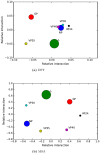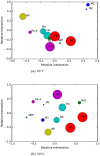A coevolution analysis for identifying protein-protein interactions by Fourier transform
- PMID: 28430779
- PMCID: PMC5400233
- DOI: 10.1371/journal.pone.0174862
A coevolution analysis for identifying protein-protein interactions by Fourier transform
Abstract
Protein-protein interactions (PPIs) play key roles in life processes, such as signal transduction, transcription regulations, and immune response, etc. Identification of PPIs enables better understanding of the functional networks within a cell. Common experimental methods for identifying PPIs are time consuming and expensive. However, recent developments in computational approaches for inferring PPIs from protein sequences based on coevolution theory avoid these problems. In the coevolution theory model, interacted proteins may show coevolutionary mutations and have similar phylogenetic trees. The existing coevolution methods depend on multiple sequence alignments (MSA); however, the MSA-based coevolution methods often produce high false positive interactions. In this paper, we present a computational method using an alignment-free approach to accurately detect PPIs and reduce false positives. In the method, protein sequences are numerically represented by biochemical properties of amino acids, which reflect the structural and functional differences of proteins. Fourier transform is applied to the numerical representation of protein sequences to capture the dissimilarities of protein sequences in biophysical context. The method is assessed for predicting PPIs in Ebola virus. The results indicate strong coevolution between the protein pairs (NP-VP24, NP-VP30, NP-VP40, VP24-VP30, VP24-VP40, and VP30-VP40). The method is also validated for PPIs in influenza and E.coli genomes. Since our method can reduce false positive and increase the specificity of PPI prediction, it offers an effective tool to understand mechanisms of disease pathogens and find potential targets for drug design. The Python programs in this study are available to public at URL (https://github.com/cyinbox/PPI).
Conflict of interest statement
Figures





Similar articles
-
Herbal Lead as Ideal Bioactive Compounds Against Probable Drug Targets of Ebola Virus in Comparison with Known Chemical Analogue: A Computational Drug Discovery Perspective.Interdiscip Sci. 2017 Jun;9(2):254-277. doi: 10.1007/s12539-016-0149-8. Epub 2016 Feb 8. Interdiscip Sci. 2017. PMID: 26857866
-
Predicting Protein-Protein Interactions via Random Ferns with Evolutionary Matrix Representation.Comput Math Methods Med. 2022 Feb 22;2022:7191684. doi: 10.1155/2022/7191684. eCollection 2022. Comput Math Methods Med. 2022. PMID: 35242211 Free PMC article.
-
Sequence analysis of the GP, NP, VP40 and VP24 genes of Ebola virus isolated from deceased, surviving and asymptomatically infected individuals during the 1996 outbreak in Gabon: comparative studies and phylogenetic characterization.J Gen Virol. 2002 Jan;83(Pt 1):67-73. doi: 10.1099/0022-1317-83-1-67. J Gen Virol. 2002. PMID: 11752702
-
Recent advances in predicting and modeling protein-protein interactions.Trends Biochem Sci. 2023 Jun;48(6):527-538. doi: 10.1016/j.tibs.2023.03.003. Epub 2023 Apr 14. Trends Biochem Sci. 2023. PMID: 37061423 Review.
-
[The properties of Ebola virus proteins].Vopr Virusol. 2006 Nov-Dec;51(6):4-10. Vopr Virusol. 2006. PMID: 17214074 Review. Russian.
Cited by
-
Mannosylated hemagglutinin peptides bind cyanovirin-N independent of disulfide-bonds in complementary binding sites.RSC Adv. 2020 Mar 17;10(19):11079-11087. doi: 10.1039/d0ra01128b. eCollection 2020 Mar 16. RSC Adv. 2020. PMID: 35495330 Free PMC article.
-
Encodings and models for antimicrobial peptide classification for multi-resistant pathogens.BioData Min. 2019 Mar 4;12:7. doi: 10.1186/s13040-019-0196-x. eCollection 2019. BioData Min. 2019. PMID: 30867681 Free PMC article. Review.
-
CBIL-VHPLI: a model for predicting viral-host protein-lncRNA interactions based on machine learning and transfer learning.Sci Rep. 2024 Jul 30;14(1):17549. doi: 10.1038/s41598-024-68750-8. Sci Rep. 2024. PMID: 39080344 Free PMC article.
-
Alignment-free sequence comparison: benefits, applications, and tools.Genome Biol. 2017 Oct 3;18(1):186. doi: 10.1186/s13059-017-1319-7. Genome Biol. 2017. PMID: 28974235 Free PMC article. Review.
-
Coevolutionary and Phylogenetic Analysis of Mimiviral Replication Machinery Suggest the Cellular Origin of Mimiviruses.Mol Biol Evol. 2021 May 4;38(5):2014-2029. doi: 10.1093/molbev/msab003. Mol Biol Evol. 2021. PMID: 33570580 Free PMC article.
References
-
- Lin C, Chen W, Qiu C, Wu Y, Krishnan S, Zou Q. LibD3C: ensemble classifiers with a clustering and dynamic selection strategy. Neurocomputing. 2014;123:424–435. 10.1016/j.neucom.2013.08.004 - DOI
MeSH terms
Substances
LinkOut - more resources
Full Text Sources
Other Literature Sources
Miscellaneous

